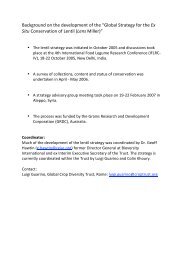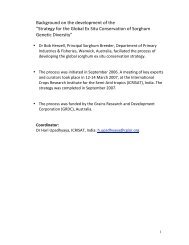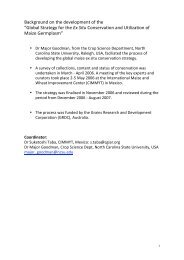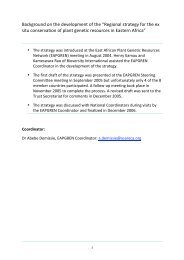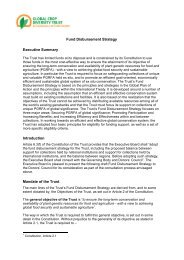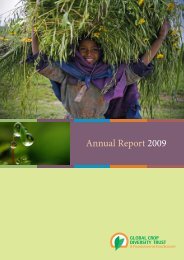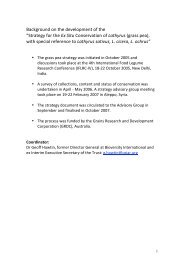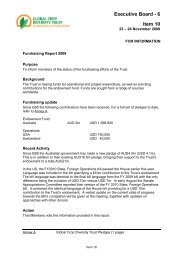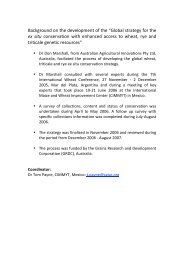Global Strategy for the Ex Situ Conservation of Potato - Global Crop ...
Global Strategy for the Ex Situ Conservation of Potato - Global Crop ...
Global Strategy for the Ex Situ Conservation of Potato - Global Crop ...
You also want an ePaper? Increase the reach of your titles
YUMPU automatically turns print PDFs into web optimized ePapers that Google loves.
Digitalisation <strong>of</strong> passport data and morphological descriptions currently available on<br />
cards or o<strong>the</strong>r <strong>for</strong>mats; <strong>the</strong> VIR morphological in<strong>for</strong>mation would need codification<br />
be<strong>for</strong>e digitalisation.<br />
Validation <strong>of</strong> morphological descriptors on field collections <strong>of</strong> collections included in <strong>the</strong><br />
project by <strong>the</strong> use <strong>of</strong> CIP minimum standard descriptors (most used and most<br />
stable). Current descriptor list needs to be translated into English be<strong>for</strong>e it can be<br />
used and distributed. <strong>Ex</strong>change <strong>of</strong> in<strong>for</strong>mation electronically.<br />
Carry out first comparative exercise using <strong>the</strong> electronic passport and morphological<br />
data. <strong>Ex</strong>change <strong>of</strong> <strong>the</strong> resulting analysis electronically.<br />
<strong>Ex</strong>tract DNA from <strong>the</strong> accessions (we estimate 1000 accessions organized into<br />
morphological groups). Send DNA samples to CIP <strong>for</strong> molecular analysis.<br />
Carry out <strong>the</strong> molecular analysis using SSR markers available at CIP. Work to be<br />
conducted mainly at CIP.<br />
Final identification <strong>of</strong> genetic duplicates using <strong>the</strong> passport, morphological and molecular<br />
data.<br />
A workshop should be held at CIP be<strong>for</strong>e <strong>the</strong> project is implemented to discuss and<br />
agree on methodologies and procedures.<br />
Budget components (estimated)<br />
• Activity 1: US $10,000<br />
• Activity 2: US $ 140,000<br />
• Activity 3: US $ 5,000<br />
• Activity 4 and 5: US $ 30,200<br />
• Activity 6: US $ 2,500<br />
Total Budget: US $ 187,000 over 3 years plus backstopping as contribution.<br />
4. Regeneration needs<br />
Title: Regeneration <strong>of</strong> endangered potato accessions<br />
Implementing /coordinating institutes: INTA will coordinate this proposal<br />
• Focal person: Andrea Clausen (INTA, Argentina)<br />
• Task <strong>for</strong>ce: Andrea Clausen (INTA, Argentina), Alvaro Monteros (DENAREF, Ecuador)<br />
Gavin Ramsay (CPC, UK), Stepan Kiru (VIR, Russia)<br />
Partners: Argentina (INTA), Bolivia (PROINPA), Chile (UACH), Colombia (CORPOICA),<br />
Ecuador (DENAREF/ INIAP), CIP (Peru) <strong>for</strong> use <strong>of</strong> <strong>the</strong> databases, Russia (VIR) and o<strong>the</strong>rs<br />
Time frame: 3-5 years<br />
Objective: To safeguard unique potato genetic resources which need urgent regeneration<br />
Process and activities:<br />
1) Identify unique material which has a high priority <strong>for</strong> regeneration; <strong>the</strong> participating<br />
collections can produce <strong>the</strong>se priority lists from <strong>the</strong>ir collections.<br />
2) The overall priority <strong>of</strong> <strong>the</strong> selected accessions should be clarified by comparing with<br />
<strong>the</strong> international databases.<br />
3) Both wild relatives and vegetatively propagated potato species will be included<br />
4) Gene bank management and facilities need to be improved in some gene banks<br />
(capacity building).<br />
5) The questionnaire estimated that in <strong>the</strong> participating genebanks 2,000 accessions <strong>of</strong><br />
wild species and 2,200 accessions <strong>of</strong> native cultivars from <strong>the</strong> centre <strong>of</strong> origin<br />
approximately need urgent regeneration. Considering that <strong>the</strong> duplication rate is<br />
approximately 50% between <strong>the</strong>se collections it would mean that 1,000 accessions <strong>of</strong><br />
wild species and 1,100 accessions <strong>of</strong> native cultivars need to be urgently<br />
regenerated.<br />
6) The regeneration should be followed by safety duplication, applying <strong>the</strong> black box<br />
principles.<br />
7) The regeneration should also consider <strong>the</strong> health aspects <strong>of</strong> <strong>the</strong> material.<br />
Budget components (estimated);<br />
71




